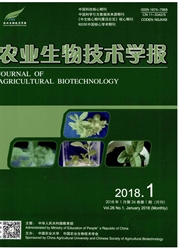

 中文摘要:
中文摘要:
筛选番茄(Lycopersicon esculentum)幼苗cDNA文库获得与番茄抗性相关的克隆E11,设计引物,利用RT-PCR方法从受到病原侵染的番茄叶片中获得长1018bp的候选片段,同源性分析发现该片段与其它作物上发表的ACO基因序列高度同源,同源率83%~99%,推断该基因为番茄ACO基因家族的新成员。在此基础上,用BP克隆的方法构建该基因的RNA干涉(RNAi)载体pD311,对番茄进行遗传转化,获得卡那霉素抗性植株27棵,分子检测证实外源片段成功导入番茄基因组中。对获得的转基因植株的乙烯生成量测定结果表明,RNAi结构的导入大大抑制了内源ACO基因的表达,从而导致乙烯的生成大大降低。
 英文摘要:
英文摘要:
A fragment of 1 018 bp of ACO gene cDNA sequence was cloned from tomato (Lycopersicon esculentum) leaves incuhated with pathogen using RT-PCR with two PCR primers designed according to the sequence of tomato cDNA clone (E11). The BLAST search result showed that the sequence presented a very high match with the ACO genes in the other plants and its homology was from 83% to 99%. Using this sequence, a RNA interference (RNAi) transformation vector (pD311) was constructed through the way of BP cloning and transformed into tomato. Twenty-seven regenerated plants with kanamycin resistance were obtained, showing that the tmnsgene integrated into tomato genome was proved by PCR and Southern blot. The ethylene respiration amount of the RNAi transgenic tomato plants was measured by gas chromatography, resulting in that ethylene evolution was specifically inhibited in leaves and fruits of the transgenic plants.
 同期刊论文项目
同期刊论文项目
 同项目期刊论文
同项目期刊论文
 期刊信息
期刊信息
